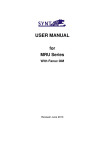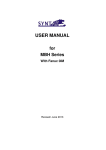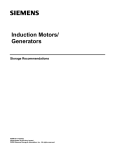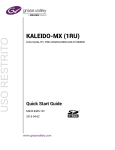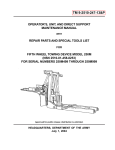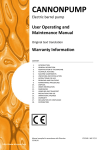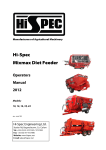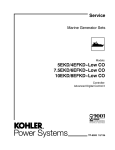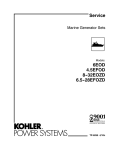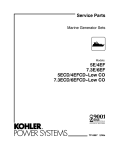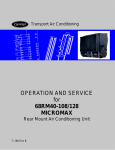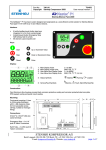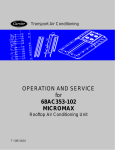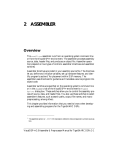Download USER MANUAL
Transcript
USER MANUAL for MRU Series With Heidenhain Control Revised: October 2013 User Manual MRU Series CONTENTS 1. Safety.......................................................................................................5 1.1 Intended Use ..............................................................................5 1.2 Important Safety Notice and Warning .........................................5 1.2.1 Safe installation ...................................................................5 1.2.2 1.2.3 1.2.4 1.2.5 1.3 1.4 Safety Cautions List....................................................................7 Safety Devices..........................................................................10 1.4.1 Emergency Stop ................................................................10 1.4.2 Guard ................................................................................10 1.4.3 1.4.4 1.4.5 1.5 1.6 2. Machine guarding................................................................6 Software ..............................................................................6 Authorized personnel and training.......................................6 Safe working practice ..........................................................6 Window .............................................................................10 Door Interlock ....................................................................10 Cabinet door lock and switch............................................. 11 Warning Labels......................................................................... 11 Residual Risks.......................................................................... 11 Introduction...........................................................................................13 2.1 Consumption Material...............................................................13 2.1.1 Lubrication oil for linear rail and ballscrew.........................13 2.1.2 Lubrication oil for pneumatic system .................................13 2.1.3 Cutting fluid .......................................................................13 2.1.4 Lubrication oil for rotary table ............................................13 2.2 Operation Panel........................................................................13 2.3 Spindle Tooling .........................................................................14 3. 2.4 2.5 Dimensions of work table..........................................................14 Tool Magazine and ATC............................................................14 2.6 Chip Removal ...........................................................................15 Installation.............................................................................................16 3.1 Foundation Preparation ............................................................16 3.2 Power Preparation....................................................................16 3.2.1 Line Configuration .............................................................16 3.3 3.4 3.5 Unpacking.................................................................................16 Machine Lifting .........................................................................17 Leveling of Machine..................................................................17 3.6 Before Power ON .....................................................................18 2 User Manual MRU Series 3.6.1 3.6.2 Grounding..........................................................................18 Power connection..............................................................19 3.6.3 Misc. ..................................................................................20 3.7 First Time Power ON ................................................................20 3.7.1 Rotation Direction of Motors ..............................................21 3.7.2 Spindle Run-in ...................................................................21 4. 5. Operation...............................................................................................22 4.1 Power ON/OFF.........................................................................22 4.2 Reference (or “ZERO RETURN” or “HOME”) the Machine ......22 4.3 Machine Warm-up ....................................................................22 4.4 4.5 4.6 4.7 Spindle Warm-up ......................................................................22 Interrupting Operation...............................................................22 Jobs Finished ...........................................................................22 Jog Axis ....................................................................................23 4.8 4.9 4.10 Jog Axis by MPG ......................................................................23 Tool Loading/Unloading ............................................................23 Large Tool management ...........................................................23 Maintenance ..........................................................................................25 5.1 Routine Inspection....................................................................25 5.1.1 Daily ..................................................................................25 5.1.2 Weekly (In addition to daily routine) ..................................26 5.1.3 Yearly (In addition to weekly routine).................................26 5.2 Lubrication................................................................................26 5.2.1 Automatic Lubrication System ...........................................26 5.2.2 FRL unit.............................................................................27 5.3 6. Trouble shooting...................................................................................28 6.1 ATC system: .............................................................................28 6.2 Cooling, Coolant and lubrication system. .................................29 6.3 6.4 7. Cleaning ...................................................................................27 5.3.1 Machine Interior:................................................................27 Door switch system ..................................................................30 Alarm messages and remedies ................................................30 Appendix ...............................................................................................31 7.1 Power requirements: 25 kVA ....................................................31 7.2 Pneumatic requirements...........................................................31 7.3 Spindle run-in procedures.........................................................31 7.4 Special M-function Codes.........................................................32 7.5 User Definable Parameters ......................................................33 3 User Manual MRU Series 7.5.1 7.5.2 7.6 Parameters editing ............................................................33 Timer table.........................................................................33 Machine floor space .................................................................34 7.6.1 MRU-32 .............................................................................34 4 User Manual MRU Series 1. Safety 1.1 Intended Use This machine is a numerically controlled machine tool designed to shape cold metal by the application of rotating cutting tools capable of performing two or more machining processes (e.g. boring, drilling, milling, thread tapping) at one set-up of a workpiece and incorporating automatic facilities to: Select and change tools from a magazine Change the position of the workpiece relative to the spindle mounted cutter. Select and apply spindle speeds and axis feeds Control ancillary services (e.g. coolant flow) This machine is intended for use in an industrial environment and must not be used in the residential, commercial and light industrial environment. Materials to be cut in this machine are: Steel, Iron, Iron casting, Bronze, Brass, Copper, and Aluminium. Materials not suitable to be cut in this machine are: Graphite, Wood, Plastic, Magnesium alloy. Consult the agent for the material not listed above. 1.2 Important Safety Notice and Warning It is the user’s responsibility to be acquainted with the legal obligations and requirements in the use and application of the machine. 1.2.1 Safe installation It is the customer’s responsibility to ensure the machine is installed in a safe operating position, with all service pipes and cables clear of the operation area so as not to cause a hazard. Access must be allowed for safe maintenance, swarf and oil disposal including safe stacking of machined and un-machined components. 5 User Manual MRU Series 1.2.2 Machine guarding This Machine is fitted with completely enclosed guards as standard. In certain cases and tooling applications additional guarding may have to be provided by the user. The standard machine guarding has special safety interlocks on the guard doors that comply with the Machinery Directive. Guards and interlocks must be kept fully maintained and tested by the customer and shall not be removed. The guards are made with clear observation windows having high impact resistance to provide operator safety and a clear unobstructed view of the operations in process. The opening of any guard door provides access to potential hazard areas. Opening of the front working area guard doors is not allowed whilst the spindle is rotating but it is still possible to manually initiate axis movements whilst these doors are open albeit at a reduced traverse rate. Extreme care must therefore be used at all times. 1.2.3 Software Unauthorized changing of machines software or control parameters is hazardous and is not permitted. The machine maker will not accept any liability whatsoever for unauthorized changes in this area. 1.2.4 Authorized personnel and training Operating, service and maintenance engineers shall be authorized by the ‘User Company’ and properly trained in the use of the machine. 1.2.5 Safe working practice Workholding devices, lifting equipment, tooling and their use shall be the responsibility of the user. It is the user’s responsibility to protect against the hazards caused by swarf, leaking oil or coolant and their use. Use of proprietary oil or coolant is the responsibility of the user. Special instructions from the suppliers concerning their use should 6 User Manual MRU Series be carefully read and understood before use. To prevent body injury, safe working practices should be employed when operating or servicing the machine. 1.3 Safety Cautions List It is the user’s responsibility to ensure all local regulations and safety instructions are followed. Users should consult with their own safety representative to ensure that all such regulations are known and acted upon. DON’T run the machine until you have made clear to your supervisor that you understand the potential hazard of spindle rotation, the throwing of coolant and the throwing of swarf from the cutting process. DON’T run the machine until you have read and understood all manuals provided with the machine. DON’T run the machine for the first time without a qualified instructor. Ask your supervisor for help when you need it. DON’T get caught in moving parts. Remove watches, rings, jewellery, neckties and loose fitting clothes. KEEP your hair away from moving parts. PROTECT your eyes. Wear safety glasses with side shields at all times. PROTECT your head. Wear a safety helmet when working near overhead hazards. PROTECT your feet. Always wear safety shoes with steel toes and oil resistant soles. PROTECT your hands. Make sure the spindle is stopped before manually changing a tool. PROTECT your hands. Make sure the spindle is stopped before manually changing a workpiece. PROTECT your hands. Make sure the spindle is stopped before manually clearing away swarf or oil. Use a brush or chip scraper. NEVER use you hands. PROTECT your hands. Make sure the spindle is stopped before 7 User Manual MRU Series manually adjusting the work piece or fixture or coolant nozzle. PROTECT your hands. Make sure the spindle is stopped before you take measurements. PROTECT your hands. Make sure the spindle is stopped before you move a safeguard. Never reach round a safeguard. PROTECT your hands. Make sure the machine is switched off and electrically isolated before making any mechanical adjustment. PROTECT your hands. Beware sharp edges of cutting tools when changing and handling tools. PROTECT your eyes and the machine. Never use a compressed air hose to remove swarf or to clean out air vents. Gloves are easily caught in moving parts. TAKE THEM OFF before you turns on the machine. Loose objects can become flying projectiles. REMOVE all loose items (wrenches, chuck keys, rags etc.) from the machine before starting. PREVENT objects from flying loose. Securely clamp and locate the work piece. NEVER operate a machine tool after taking strong medication, using non-prescription drugs, prescription drugs or consume alcohol which may impair concentration. ALWAYS make sure the working and cutting zone is safeguarded. KEEP the work area well lighted. Ask for additional lighting if needed. DON’T slip. Keep your work area clean and dry. Remove swarf, oil and obstacles. NEVER lean on the machine. Stand away when machine is running. DON’T get trapped. Avoid pinch points caused between other machines and the machine you are working. PREVENT cutter breakage. Use correct cutter speed and axis feed rate for the job. Make manual over ride adjustments of axis feed rate or spindle speed if you notice unusual noise or vibration. Ask your supervisor for help if you need it. PREVENT cutter breakage. Rotate the spindle in a clockwise direction for right handed tools, counter clockwise for left handed tools. Use the correct tool for the job. 8 User Manual MRU Series PREVENT work piece and cutter damage. Never start the machine when the cutter is in contact with the work piece. Dull and damaged tools break easily. Inspect tools and tool holders. Keep tools sharp. Keep overhang short. KEEP all lubrication reservoirs maintained at the correct level. Always keep to the maintenance schedule. Certain materials such as magnesium are highly flammable in dust and chip form. See your supervisor before working these materials. PREVENT fire. Keep flammable liquids and materials away from the work area and from hot swarf. PREVENT the machine from moving unexpectedly. When leaving the machine unattended, not producing, leave switched in the MANUAL mode. DON’T use the machine in a volatile atmosphere. Electrical devices fitted to the machine are for normal factory use and are not explosion proof. ALWAYS keep the machine clean and do not let swarf collect. ALWAYS keep the area around the machine clean and tidy. Opening the guards creates the potential for residual coolant and swarf to fall to the swarf tray and possibly to the floor. Good housekeeping minimizes the potential for trips, slip or fall of all personnel. INFORM all other personnel who approach the machine about the hazards described in this safety list. When making adjustments with spanners, always ensure that the required leverage is safely applied. Always avoid slippage. Always apply the leverage by pulling, never by pushing. Always use the correct size spanner. Ensure the spanner is not damaged. Do not use organic chemical solvents to clean the machine guards or compressed air services equipment. The windows are manufactured from bulletproof polycarbonate sheet. This material does deteriorate with age, and should be exchanged within the time period described later in this manual. Any workholding device used in conjunction with this machining centre must fit within the working envelope available. Under no circumstances must any such workholding device be used when it would require the need to override/defeat the safety interlocks fitted 9 User Manual MRU Series as standard to this machine. 1.4 Safety Devices 1.4.1 Emergency Stop Make yourself aware of the location of the emergency stop push buttons, which should be well known so that they can be operated at any time without the need to look for them. Test the push buttons periodically for their correct operation. The emergency stop push buttons is located on the operator panel. Once the Emergency Stop button is pressed or any of the over travel limit switches have been operated, the machine will stop immediately and the power supply to the drives is removed, and go into an Emergency Stop condition 1.4.2 Guard Machine equipped front door, ATC door, side door and full guard as safety device to protect operator. Doors are not allowed open in any time when machining. 1.4.3 Window Machine equipped with 9.5 mm thickness PC safety glass on front and side guard. The window impact resistance capacity is at 821.8 kg.m. Any crack on the window is not allowable. 1.4.4 Door Interlock The machine has 1 interlocked main access door at the front. The main door is shot bolted shut and can only be opened once the spindle is stationary and there is no program running. Power On Safety Circuit (Allows the operator to execute certain tasks whilst the front door is open) Limited machine functionality is available to the operator whilst the main door is open. The handwheel and jog keys are allowed to move the machine axes at feed rates of 1260mm/min and less. Spindle 10 User Manual MRU Series operation is prohibited whilst the main door is open as the spindle contactor is hard wired through the door interlock switch. Selection of automatic program running is prohibited until the doors are shut. 1.4.5 Cabinet door lock and switch The main power switch of machine must be shut off and turned further CCW to open the cabinet door. 1.5 Warning Labels Most of the warning labels are self-explained as following: 1.6 Residual Risks The machine tool has been designed and manufactured to the highest standards, but still, your attention is drawn to the following RESIDUAL RISKS existing within the machine. Always check that the cutting tool product you are using is approved to run at the selected speed. If non suitable cutting conditions are selected, coolant can 11 User Manual MRU Series splash, and swarf can escape over the sides of the guard. Failure of the Z-axis servo motor brake could allow the head to fall when the power is OFF Do not operate the machine with the side door access panels removed. Isolate the machine before cleaning the machine through the side door access panels 12 User Manual MRU Series 2. Introduction 2.1 Consumption Material 2.1.1 Lubrication oil for linear rail and ballscrew Lubrication oil for linear rail and ballscrew are as follow: Qt’y Recommended oil 4 liter FEBIS K68 (ESSO) VACTRA NO.2 (MOBIL) TONNA OIL T68 (SHELL) 2.1.2 Lubrication oil for pneumatic system Oil for pneumatic system is recommended to use same specification of ESSO TERESSO 32 or SHELL TELLUS OIL 32. Total quantity oil for machine in every half year need 120 cc. 2.1.3 Cutting fluid Cutting fluid and mixing ratio with water are recommended by following table. Coolant tank capacity is 160 liter. Marker: Castrol No. Type Application Dilution ratio with water 1 SYNTIOL-9913 Aluminum cutting only 1:15 2 ALUSBL-B Aluminum cutting only 1:15 3 HYSOL-X Various material cutting 1:20 2.1.4 Lubrication oil for rotary table Lubrication oil with viscosity ISO-VG100 to 150. 2.2 Operation Panel Please refer to Heidenhain manuals. 13 User Manual MRU Series 2.3 Spindle Tooling Tooling with a balance level of G2.5 or better should always be used. Failure to do so will reduce spindle life and surface finish and may invalidate the machine warranty. For safe operation, make sure the tool holder and pull stud combination meet the standard below: BT-40 DIN-40 (CAT-40) 2.4 Dimensions of work table 2.5 Tool Magazine and ATC 14 User Manual MRU Series Tools magazine ATC cam box Tool Change Arm 2.6 Chip Removal Chips were washed away from the interior of machine and flow into the chute where the chip screw augers or chip conveyor located. Then chips were collected at the exit of screw auger or conveyor. 15 User Manual MRU Series 3. Installation 3.1 Foundation Preparation The machine should be sited on a flat area (maximum fall 3mm in 3 m) free from cracks and expansion joints. The composition of the floor and sub-structure should be of suitable construction to bear the weight of the machine. Any friable areas should be made good using recognized building construction techniques. If doubt exists we recommend you consult your building architect. 3.2 Power Preparation 3.2.1 Line Configuration The machine is designed to operate from a 3-phase AC incoming power source with an earth star point, as shown in the right. This incoming line short circuit current must be at least 2kA. In other cases, such as those examples shown in figures below, an isolating transformer of 15kVA or larger capacity with an earth grounded WYE secondary is required between the incoming lines and the machine. The incoming line short circuit current must again be least 2kA. Other Incoming Line Configurations 3.3 Unpacking 16 User Manual MRU Series The machine was fixed on a skid during which could be pulled to the opening of container and then moved by a fork lifter. Select a chain according to the weight of the machine. Tie the chain to the skid and make sure the connection is secured. Slowly pull the machine and monitor the gap between the machine and the wall of the container. 3.4 Machine Lifting Any lifting cables and slings must be rated to take the machine’s weight. If the machine is to be lifted by Fork Truck, the minimum capacity should be 120% of the machine weight and with a minimum tine length of 2,000mm. 3.5 Leveling of Machine a) Make sure the location of the machine is exactly where you need it to be. Ensure allowance for access for operation, cleaning and maintenance is provided. See the installation dimensional drawing for minimum clearances. b) Locate the floor pads which are packed with the associate kit and position them on the floor under each jack bolt. When satisfied 17 User Manual MRU Series lower the machine gently onto the pre-located pads. Ensure jack bolts are screwed down to provide a 10 to 15mm gap from the underside of the base casting to the floor. c) If you use skates then employ the jack bolts with suitable support packing to raise the machine enough to remove the skates and finally set onto the floor pads. 3.6 Before Power ON 3.6.1 Grounding a) The machine must be grounded in order to protect personnel and the machine from electrical hazards. Grounding must be in accordance with the standards for electrical equipment. b) Ideally, the grounding point should be as close as possible to the machine. c) A qualified electrician must carry out the grounding work, otherwise serious injury, death, or accidents involving machine damage could result. d) The machine must be grounded in one of the following ways: 1) Independent grounding 2) Common grounding Regardless of the type of grounding system used, the earth loop impedance of the supply, which connects the machine to ground/earth, must not exceed 1 ohm. e) Never ground the machine in the manner shown in the illustration below. 18 User Manual MRU Series No more than one grounding conductor wire can be connected to a single terminal. If the grounding conductors are connected in the manner shown in the illustration above, a faulty connection at one of the terminals could cause grounding current to be fed back to the machine, resulting in serious accidents. Once the electrical and air supplies are provided make the connection to the machine. The delivery dimensional drawing gives details of input locations. ON NO ACCOUNT MUST YOU SWITCH ON THE MACHINE. WE PREFER YOU TO REMOVE YOUR ISOLATOR FUSES OR TRIP CIRCUIT BREAKERS. 3.6.2 Power connection A qualified electrician should only carry out connection of the power lead to the machine. Cables, cords or electric wires of which insulation is damaged can produce current leaks and electric shocks. Check their condition before connecting. Ensure the power cable to the machine main isolator has sufficient current carrying capacity to handle the electric power used. Cables which must be laid on the floor, must be protected against chips, oil and coolants penetration, which might cause damage. In the event of power failure, turn off the main circuit breaker 19 User Manual MRU Series immediately. Fuses and circuit breakers should be replaced only with suitably rated alternatives. Safety devices should be replaced only with the machine manufacturers recommended parts. Protect the CNC unit, operating panel, and electric cabinet etc from shocks which could cause a failure of malfunction. Connect the power cable to main power terminal block. Ensure the sign rotation of R, S, T phases. Connect the ground cable to the Earth bar. 3.6.3 Misc. Check the condition of the warning labels. If they are missing or become illegible, order replacements from your distributor according to the part number on the label plate. Do not remove warning labels. After unpacking the machine clean all rust preventatives from the machine with a non-volatile cleaning fluid. Lightly lubricate each sliding part before trying to operate the machine. Manually operate the lubricating oil pump until oil oozes out from the slide way wipers. Oil volume should be filled to the indicated level. Check and top up if necessary. Use recommended oil brands and appropriate levels for all lubricating systems. See the instruction plate at the rear of the machine. The coolant system comprises of a separate tank which houses the coolant pumps and is located beneath the front and left sides of the machine. 3.7 First Time Power ON 20 User Manual MRU Series 3.7.1 Rotation Direction of Motors The rotation of 3-phase motors of pumps, chips removal and fans might be reversed due to the different phase sequence of city power U, V and W. Please confirm the rotation of all the coolant pumps and cooling fans. 3.7.2 Spindle Run-in The grease inside the bearings of spindle might be concentrated by gravity due to temperature variation during the transportation and storage. It is a MUST to run the spindle following the procedures described in Appendix. 21 User Manual MRU Series 4. Operation 4.1 Power ON/OFF Please refer to Heidenhain manuals. 4.2 Reference (or “ZERO RETURN” or “HOME”) the Machine Usually this is not needed since this machine is with absolute axis encoders. Please refer to Heidenhain manuals, if you do need to do. 4.3 Machine Warm-up ** If the machine is used to produce components immediately after being started, following a long idle period, sliding parts may be worn due to lack of oil and thermal expansion of the machine can jeopardize machining accuracy. To prevent this condition, always warm the machine up. ** We recommend that the machine is ‘Warmed up’ prior to operation by running all axes for 20 minutes at the speed of actual cutting in the automatic operation mode. The spindle speed should be gradually increased up to actual cutting speed. 4.4 Spindle Warm-up If the following procedures are not followed, spindle life will be reduced significantly. Follow the speed and running time duration in the table for each type of spindle. Please note that the duration is either in minutes (m) or in seconds (s). 4.5 Interrupting Operation When leaving the machine temporarily after completing a job, turn off the power on the operator panel with the Emergency Stop button and turn off the main isolator. 4.6 Jobs Finished 22 User Manual MRU Series Always clean the machine and supporting equipment down after use. Remove and dispose of chips and clean the covers and windows etc. Return each machine component to its initial condition. Check wipers for damage and replace if necessary. Check coolants, hydraulic oils and lubricants for level & contamination. Change them if you suspect they are contaminated. Clean the filter on the top of the coolant tank. Turn off the power first on the control panel with the emergency stop button and then at the main isolator before leaving the machine at end of the shift. 4.7 Jog Axis Please refer to Heidenhain manuals. 4.8 Jog Axis by MPG Please refer to Heidenhain manuals. 4.9 Tool Loading/Unloading Open guard door of machine. While holding the tool, press and hold the clamp/unclamp button on the machine head to release the tool (See illustration). Replace tool and release the button to clamp. Close guard door of machine. Using AUTO or MDI, load the correct tool number into the Magazine. 4.10 Large Tool management 23 User Manual MRU Series Please refer to Heidenhain manuals. 24 User Manual MRU Series 5. Maintenance DANGER! Before carrying out any maintenance work, ensure that the machinery is switched off and disconnected from the main power supply. Also ensure that the necessary warning signs and /or locks are appointed to stop any unauthorized persons from switching the power on to the machine until the work is complete and the machinery is safe to operate. The above warning signs or indications should be secured by a semi-permanent means with the printing clearly visible. Only qualified and competent maintenance engineers should carry out machinery maintenance work. Working on live electrical equipment must be carried out by only suitably qualified electricians. WARNING! Over travel limit switches, proximity switches and interlock mechanisms including all functional parts should not be removed or modified. When working in high places, use steps or a ladder which are maintained daily for safety. Use only fuses, manufacturers. cable's etc. from reputable recognized CAUTION! The maintenance person should check that the machine operates safety after the work is completed. Maintenance and inspection data should be recorded and kept for reference. 5.1 Routine Inspection 5.1.1 Daily 25 User Manual MRU Series 1. Check pressure gauges for proper reading. Air pressure 5.5bar (80psi). Hydraulic pressure 68bar (986psi) 2. Check that there is sufficient oil in the air lubricator. 3. Check motors and other parts for abnormal noises. 4. Check the lubrication of sliding parts for evidence of proper lubrication. 5. Check safety covers and safety devices for proper operation. 6. Check coolant level and fill as necessary. 7. Clean dirt and chips from the axes and empty the swarf trays. 5.1.2 Weekly (In addition to daily routine) 1. Clean chips and dirt from the entire machine and wipe down. 2. Check the air filter at the rear of the electrical cabinet. Replace the filter element if it is contaminated. 3. Check all polycarbonate vision panels for signs of damage – crazing, cracking etc. or reduced visibility and replace if necessary. Contact your distributor for details. 4. Check the spindle cooler/chiller is running properly and the coolant temperature is near the temperature setting. 5. Check the spindle front draining hole from labyrinth is not jammed by dirt. 6. Check the air purging at the spindle nose. Run the spindle for 10 seconds and stop. Listen or feel the air flowing from the gap between the spindle shaft and housing. 5.1.3 Yearly (In addition to weekly routine) 1. Remove the filter from the air filter bottle and clean/replace. 2. Check spindle drive belt condition and tension. 3. Check lost motion. 4. Check the condition of the linear rail wipers. 5. Check the integrity of the electrical connections and inspect the condition of the insulation. 6. Check condition of coolant filters and replace if necessary. 7. Replace the lubrication oil in rotary table once a year. 5.2 Lubrication 5.2.1 Automatic Lubrication System Lubricator supply 1cc oil to lubricate ballscrew once time every 15 minutes. Oil discharge volume can be adjusted by a handle and 26 User Manual MRU Series illustration on the oil tank. 5.2.2 FRL unit FRL unit offer air cleaning and air lubricating function. The lubricating oil discharge rate could be adjusted by a knob on FRL unit. 5.3 Cleaning 5.3.1 Machine Interior: Chip might spatter and accumulated inside of MAGAZINE guard or somewhere that washdown coolant can’t reach after machining. Oil/coolant condensation might be accumulated inside of HeadStock and effect machine operating in good condition. It needs to be check or clean out. 27 User Manual MRU Series 6. Trouble shooting 6.1 ATC system: 1. Tools falling down when arm rotating: Tool can not be clamped well due to arm grip or stop pin is seized or arm and spindle are not aligned. 2. Tool change sequences were not finished: Attention MUST be paid when finding and getting rid of the causes. The air supply might be not quick enough or the alignment was gone. Please use the buttons as shown below to do single sequence in the tool changing to diagnose. Tool Change Functions 28 User Manual MRU Series Spindle orientation To Z axis TC position Spindle clamped Spindle unclamped Service mode Magazine CW Arm engaged Magazine CCW Arm swing Magazine Home Arm home 6.2 Cooling, Coolant and lubrication system. 1. Lubrication oil level too low 29 User Manual MRU Series Refill lubrication oil into tank 2. Lubrication pressure too low Refill lubrication oil or replace whole lubricator unit. 3. Coolant pumps noise. Pump sealing is break down or chip materials invade into pump. 6.3 Door switch system 1. Front door is opened Close front door or replace interlock switch 6.4 Alarm messages and remedies Please refer to Heidenhain manuals for the alarm messages except: Alarm No. Alarm Message Cause Remedy 260 CTS filter pressure high Filter was dirty and jammed. Pressure switch bad Check filter and replaced if it is dirty. Check the pressure switch and replaced if it is bad. 261 Oil cooler malfunction Oil cooler not function normally. Check the alarm code at the display of oil cooler and refer to the manual of oil cooler. 30 User Manual MRU Series 7. Appendix 7.1 Power requirements: 25 kVA 7.2 Pneumatic requirements Unit Value Pressure bar > 5.5 Flow rate Litre/min > 400 Dew point (at ATM. Pressure) °C -17 or lower Note: The air supply must be clean (40micron particulate size) and dry. Do not connect direct to a compressor with a short pipe as water/oil may condense out and cause a potential seizure of the spindle bearings through the air purge circuit. An air drier unit is recommended. 7.3 Spindle run-in procedures 12000 rpm Speed 10000 rpm Time (rpm) Speed 8000 rpm Time (rpm) Speed Time (rpm) 1000 5m 1000 5m 1000 5m 5000 3s 5000 3s 5000 3s 2000 5m 2000 5m 2000 5m 10000 3s 10000 3s 9000 3s 3000 5m 3000 5m 3000 5m 12000 3s -- -- -- -- 4000 5m 4000 5m 4000 5m 5000 5m 5000 5m 5000 5m 6000 5m 6000 5m 6000 5m 7000 5m 7000 5m 7000 5m 8000 5m 8000 5m 8000 5m 9000 5m 9000 5m 10000 5m 10000 5m 11000 15 m 12000 15 m 31 User Manual MRU Series 7.4 Special M-function Codes Function Description M21 External air ON M22 External air OFF M23 Wash down ON M24 Wash down OFF M931 Renishaw tool break M932 Renishaw latch M933 Renishaw reset nci 4 M934 TT air ON M935 TT air OFF 32 User Manual MRU Series 7.5 User Definable Parameters 7.5.1 Parameters editing Please refer to Heidenhain manuals. 7.5.2 Timer table Timer variables DATA seconds /ts:TS_key_pulse_recognition 0.5 /ts:TS_pulse_250_ms 0.25 /ts:TS_gear_timeout 30 DISCRIPTION Time allowed before timeout alarm of gear change /ts:TS_gear_rotation_cw 0.35 Time of CW at gear change /ts:TS_gear_rotation_ccw 0.15 Time of CCW at gear change /ts:TS_gear_rotation_pause 0 Time pause after gear change /ts:TS_lubrication 5 Time duration after lubrication pressure built /ts:TS_lubricant_pressure 15 Time waiting for lubrication pressure to build /ts:TS_hydraulic_pressure_ok 10 /ts:TS_start_index_table 1 Time delay before checking hydraulic pressure /ts:TS_Timer_1_min 1.5 /ts:TS_extern_DC_voltage_on_off 1.5 Time duration to turn OFF the DC voltage /ts:TS_extern_DC_voltage_off_on 1.5 Time duration to turn ON the DC voltage /ts:TS_TCM_exact_position 0.3 /ts:TS_TCM_timeout 120 /ts:TS_TCM_stop_delay Time allowed before timeout alarm of tool change 0 /ts:TS_TC_timeout 120 /ts:TS_TC_timer_universal 0.25 /ts:TS_TC_arm_middle_delay 0.25 /ts:TS_TSxxx_blow_off 0 Time for blow OFF of TSxxx /ts:TS_S1_blow_after_CTS_off 3 Time of blow ON after CTS OFF /ts: TS_gear_output_delay_on 1 Time delay of gear change output ON /ts:TS_gear_output_delay_off 0.5 Time delay of gear change output OFF 33 User Manual MRU Series 7.6 Machine floor space 7.6.1 MRU-32 34


































